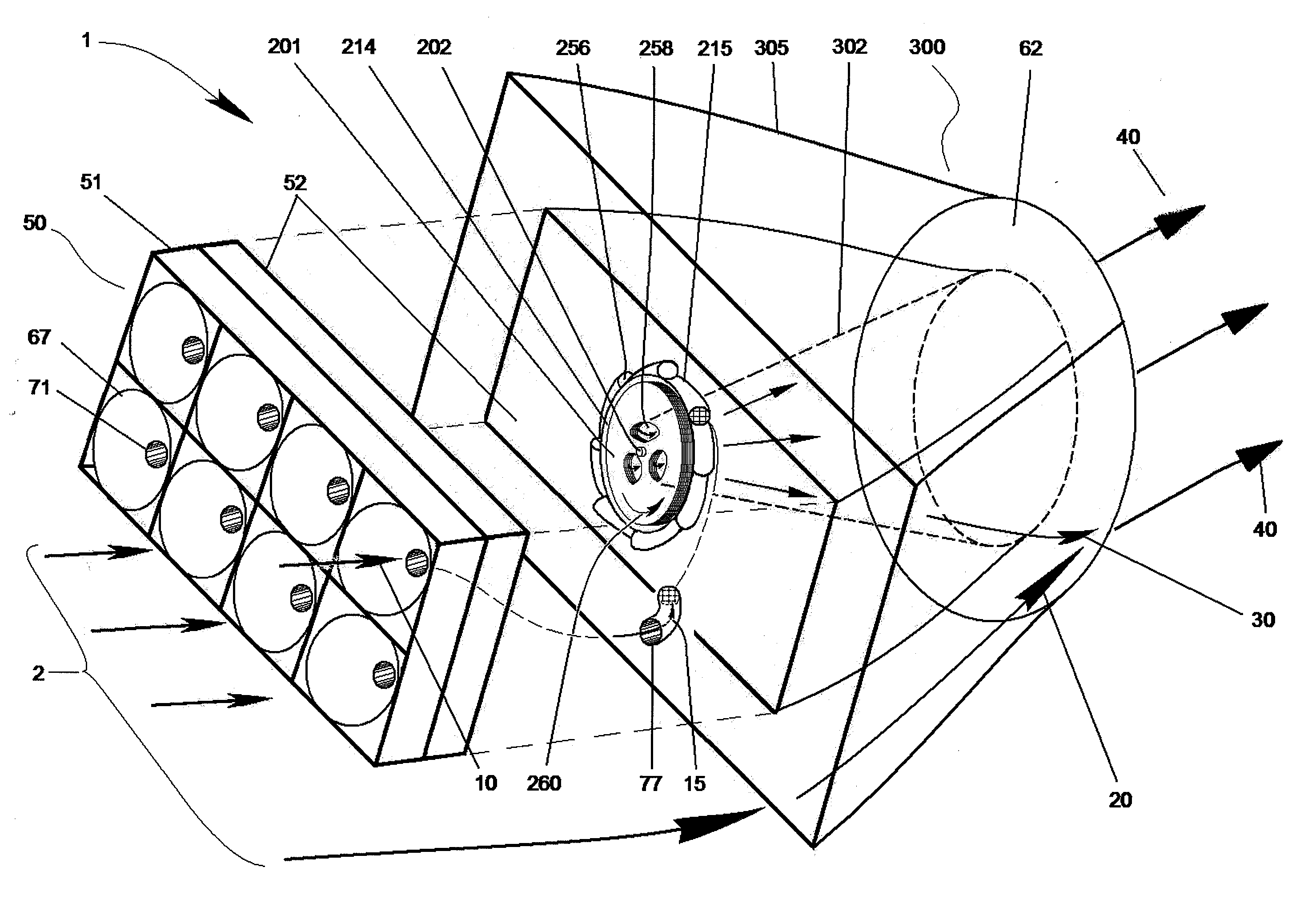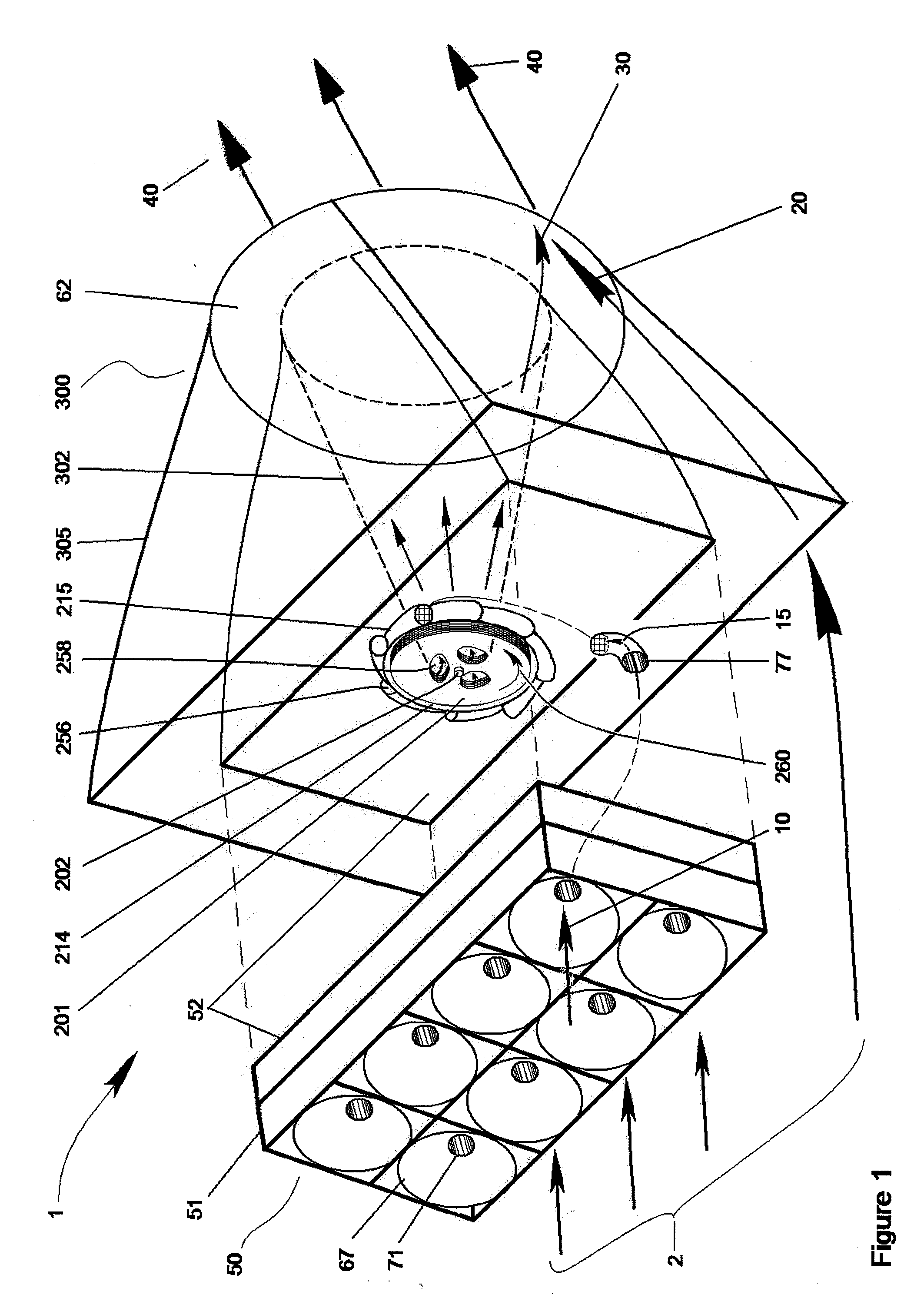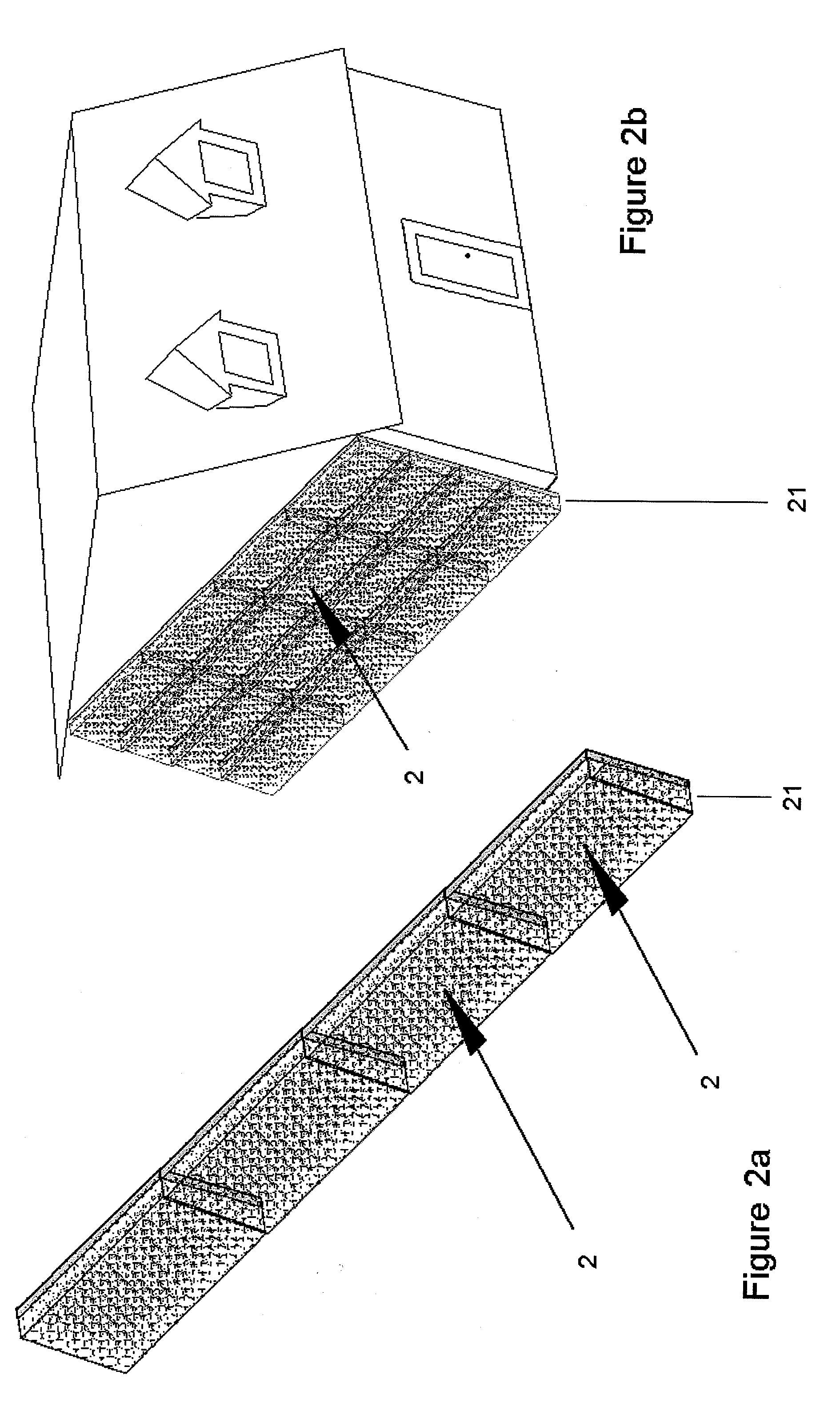It is appreciable, however, that while appendages responsible for developing rotation may be designed to render minimized flow obstruction and may advantageously induce airfoil (or hydrofoil) speed
beneficiation, a sizeable component of the
working fluid's
kinetic energy is nevertheless rendered unavailable for work conversion by such machines due to losses owing to: the shock of fluid impingement upon appendages exposed to the moving fluid streams, and the
resultant re-direction and eddying of fluid molecules resulting from the process of driving certain prior art rotors at 90° to the applied fluid currents for at least part of their cycle; the ‘swirl’ effect caused by fluid discharging tangentially and in some cases radially from bladed or annular rotors due to surface adhesion and centrifugal forces acting over the rotating blade profile contributing to the development of wasteful down-
stream vortices; all components working to produce a disadvantageous backpressure effect tending to
resist the forward
momentum of subsequent fluid flow though the same cross-section.
Attempts to reduce these effects have been made in some prior art such as by varying
appendage pitch or
yaw relationships with respeu io some
reference plane at key positions, with varying success, however, to compensate for the disadvantageous backpressure [ike effect, underutilization of swept areas is practiced by design, as evidenced by fluid-energy in a given cross-sectional area being allowed to pass through the area scribed out by the prior art appendages which occupy a limited percentage of the swept areas io minimize the so-called Betz effect, defining the limiting efficiency of machines extracting energy from fluid currents in motion.
Unfortunately and typically, this involves the diversion of significant
water resources into pen-stocks bound for points of generation some distance away, which invites ecological concern due to its considerable effect upon the
habitat of aquatic life, a consequence that true RISEC applications may avoid.
While prior art in the emerging field of tidal in-
stream energy conversion (TISEC) harvests
clean energy from
seawater in motion, these typically bladed devices present danger of injury to aquatic life which may be driven under powerful tidal or oceanic currents unto
impact with rotating blades disposing moving obstacles in the path of indigenous aquatic creatures.
Whereas skirt augmenters (5) may be employed to develop venturi-like
pressure reduction behind bladed rotors housed within the skirts to increase rotor speeds and extractable
power output with the generation of greater flow-rates there-through, these devices may concurrently increase the risk of more serious injury to aquatic life through the speed increases sought, especially <ι the blade extremities.
Whereas collectors in the method provide added energy to turbines for conversion, these types of turbines suffer losses similar to those already described in respect to bladed turbines, and no means is provided for discharging into lower than
ambient pressure fluid streams to increase the efficiency of the method.
The advantages disclosed by Finney (9) for use in various fluids including air and water further providing dramatic velocity and power increases in working mediums at length applied to axial turbines located adjacent the
throat of serially staged Venturis of sequentially larger cross-sections are significant, however, are also subject to energy losses described through their utilization of bladed turbines.
While Bosley (I]) offers inherently minimized electrical generation losses leading to less heat loading of waters surrounding TISEC devices, even with the optionally proposed flow-enhancing shroud, the annular rotor comprising a plurality of paddles introduces bladed art deficiencies already discussed, and no
impeller improvements are suggested to improve rotor speeds for greater conversion gains.
The wind-
turbine of Stanton (14) suggests form-induced air acceleration with a funnel shaped
concentrator and axial bladed turbine to harvest energy from the added pressure differential obtained via
discharge of energized turbine
throughput into a lower pressure region in the lee of the proposed collector, however, Stanton's method is also subject to the disadvantages described regarding bladed turbine losses, and similarly does not expound upon an advantageous method to further reduce downstream
discharge back-pressures.
Also, this method neither suggests nor enables service m non-com pi essible fluid environments as the 5% outlet to inlet cross-section disclosed would tend to stagnate the bulk of the fluid
mass in water applications.
Bladed
horizontal axis wind turbines and arrays thereof, generally thought to comprise modern-day wind-farms typically provide increased power benefit through installation in high wind areas, however, these areas may be coincident with fly-zones and / or nesting grounds of eagles, falcons and other endangered bird species put at risk of injurious collision with the moving rotors of such machines.
Technologically assuming great proportion in part to overcome anticipated, previously described losses observed, bladed prior art
spinning faster in high ground areas put birds of flight at
increased risk of consequence.
Further, the aesthetics of visual and sonic impacts in residential and other areas currently limit the extent to which wind energy harvest as it is known today is utilized.
While offering large fluid collection surface areas and low ambient work generation fluid
cut-in speeds, and rotors utilizing the
Magnus effect for positional stability, they may otherwise adversely present obstacles for aviators, the
power extraction capacity offered therein are nevertheless lower than bladed wind turbines.
While affording speed
beneficiation of approaching wind via the convergent-divergent external guiding means disclosed, the disposition of internal disc-separating
helical surface appendages provided may otherwise limit the efficiency of the disc turbine internalh employed, since to provide best effect,
working fluid in disc turbines should be free to travel in natural streamlines of least resistance (1) to maintain laminar flow between co-rotating discs.
Whereas this may require that
working fluid complete possibly man\revolutions between disc surfaces for optimal effect, this requirement is largely prevented in the method by the inter-disc ribs forcing working fluid to follow multiple pre-designated trajectories each potentially introducing turbulence between discs and efficiency losses accordingly.
In general, issues such as
low frequency noise from rotating blades
slicing through gaseous and liquid fluids,
cavitation of liquid fluids into gaseous
fluid inclusions disrupting laminar flows across work generation surfaces further affecting both
noise levels and power outputs alike in
underwater turbines, and the gereral lack of machines able to engage greater fluid cross sections in work generation and or conversion currently limits the timely maximization of energy returns from machines of the prior art.
 Login to View More
Login to View More  Login to View More
Login to View More 


